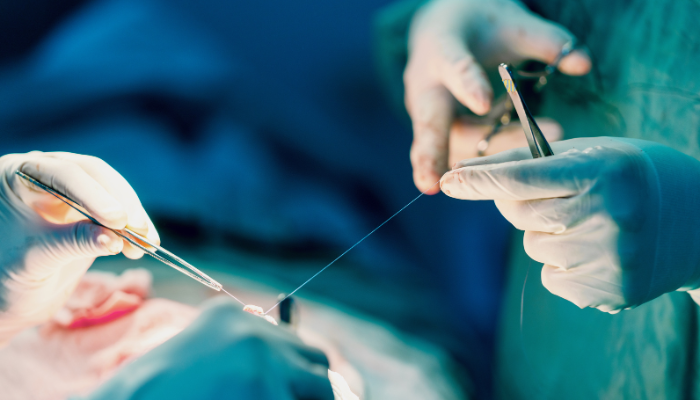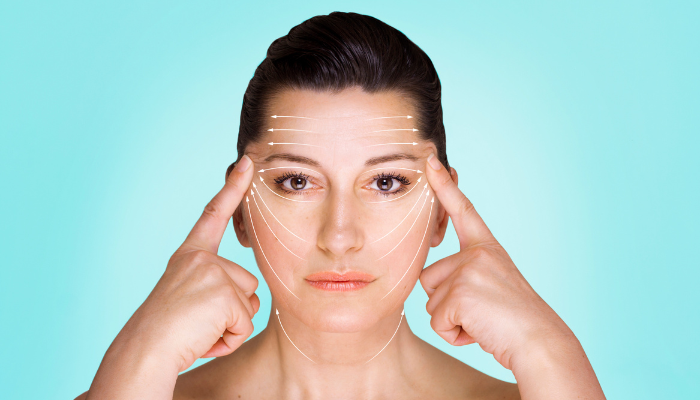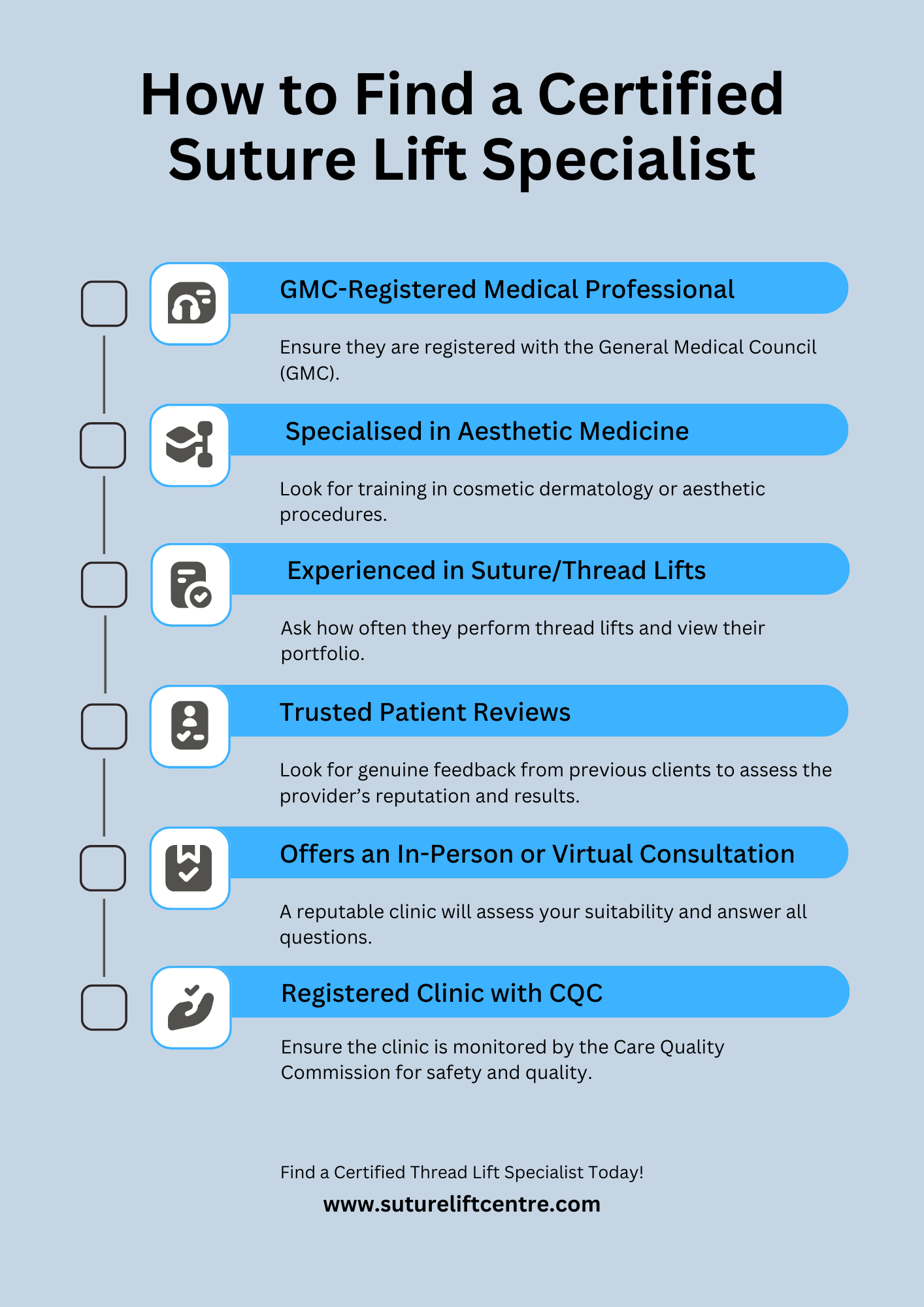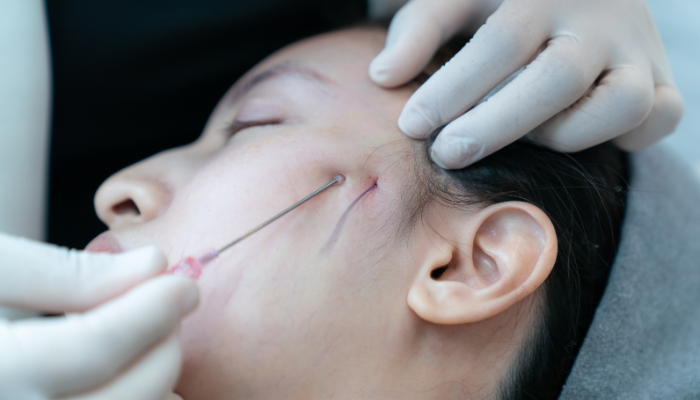Heard of the “lunchtime facelift”? That’s the buzz around suture lifts—quick, subtle, and no scalpel in sight.
If you’re new to the idea or just curious, you’re in the right place. This beginner-friendly guide breaks down what a suture lift really is, why it’s gaining popularity, and what most people wish they knew before getting one.
Let’s keep it simple—and worth your scroll.
Key Takeaways
- A suture lift is a minimally invasive procedure that uses special threads to gently lift and reshape your skin, without needing a full operation.
- Unlike some other options, suture lifts offer results that are designed to last, giving you a natural-looking enhancement.
- Recovery is usually pretty quick, so you won’t be out of action for long, making it a great choice for busy people.
- This procedure can help your skin make more collagen, which means better firmness and texture over time.
- Picking a specialist who really knows their stuff is super important for getting good results and feeling safe.
Understanding Suture Lifts for Beginners

What Is a Suture Lift?
Is the thought of going under the knife isn’t exactly your cup of tea? That’s where suture lifts come into play. A suture lift is a minimally invasive procedure designed to lift and contour the skin without the extensive surgery of a traditional facelift.
Think of it as a subtle tweak, a gentle nudge back to a more youthful you. It’s a fantastic option if you’re noticing early signs of sagging and want a refreshed look without a long recovery. It’s all about enhancing what you already have, not drastically changing it.
How Does a Suture Lift Work?
Special medical-grade threads are inserted beneath the skin to lift and support any sagging tissues. These sutures have tiny barbs or cones that grip the skin, allowing the doctor to gently lift and reposition the skin.
The procedure is performed using local anaesthetic, so it’s relatively comfortable. The best part? The sutures also stimulate collagen production, which helps to improve skin firmness and elasticity over time.
Benefits of Choosing a Suture Lift
Why should you even consider a suture lift? Here are a few reasons:
- Minimally Invasive: No large incisions mean less risk of scarring.
- Quick Recovery: Downtime is minimal, so you can get back to your life sooner.
- Natural-Looking Results: Subtle enhancements that refresh your appearance without looking ‘done’.
Suture lifts offer permanent results, unlike the temporary effects of thread lifts. They are minimally invasive, leading to shorter recovery times and less discomfort. Both procedures stimulate collagen production, improving skin quality over time. Choosing between suture lifts and thread lifts depends on your desired treatment plan.
Suture Lift Versus Thread Lift: Making an Informed Choice
You’ve probably come across both suture lifts and thread lifts. Both aim to give you a more youthful look, but they achieve it in different ways. Let’s break down the key differences so you can make the best choice for your needs.
Key Differences Between Suture Lifts and Thread Lifts
The main thing to remember is that suture lifts and thread lifts aren’t the same thing. Thread lifts use threads that dissolve over time, offering a temporary lift. Suture lifts, on the other hand, use permanent sutures to provide a lasting lift.
Think of it like this: thread lifts are a quick fix, while suture lifts are a more permanent solution.
Here’s a quick comparison:
| Feature | Suture Lift | Thread Lift |
|---|---|---|
| Sutures | Permanent | Dissolvable |
| Longevity | Long-lasting | Temporary |
| Invasiveness | Minimally invasive | Minimally invasive |
| Best For | Lasting facial rejuvenation | Quick, short-term improvements |
Longevity and Results: What to Expect
With a thread lift, you’ll typically see results for about 6-12 months. The threads dissolve, and the lift gradually fades. A suture lift, because it uses permanent sutures, offers results that can last for many years.
Of course, everyone’s different, and factors like your skin type and lifestyle will play a role, but generally, you can expect a much longer-lasting effect with a suture lift.
Why Suture Lift is the Ideal Alternative
If you’re after a solution that gives you a natural-looking lift and lasts for years, a suture lift is the way to go. It’s minimally invasive, meaning less downtime and less risk of complications compared to a traditional facelift.
Plus, the results are subtle and natural, so you’ll look like a refreshed version of yourself, not like you’ve had work done.
Choosing between a suture lift and a thread lift really comes down to your goals. If you want a quick, temporary fix, a thread lift might be suitable. But if you’re looking for a lasting solution that will keep you looking younger for years to come, a suture lift is the better choice. As always, a consultation with a qualified practitioner is essential to determine the best course of action for your individual needs.
Exploring Specific Suture Lift Applications

Suture lifts aren’t just a one-size-fits-all solution; they can be tailored to address specific areas of the face. Let’s explore some common applications to give you a better idea of what’s possible.
Understanding the Chin Suture Lift
Ever wished for a more defined jawline without undergoing major surgery? A chin suture lift might be the answer. This procedure gently lifts and contours the lower face, creating a more sculpted and youthful appearance.
It’s ideal for those noticing early signs of sagging or a loss of definition in the chin and jaw area. The sutures are strategically placed to provide support and lift, resulting in a natural-looking enhancement.
The Nose Suture Lift Basics
Thinking about tweaking your nose but dreading the idea of a traditional rhinoplasty? A nose suture lift offers a minimally invasive alternative. Instead of cutting and removing cartilage or bone, special sutures are used to reshape and lift the nose. It’s a great option for making small adjustments, such as:
- Correcting a slightly crooked nose
- Refining the nasal tip
- Improving the results of a previous nose job
The procedure is relatively quick, and the recovery time is typically shorter compared to traditional surgery. However, it’s important to have realistic expectations and understand that the results may not be as dramatic as with a full rhinoplasty.
Guide to Brow Suture Lift Recovery
A brow suture lift can make a surprising difference in your overall appearance. It’s designed to lift and reshape the eyebrows, creating a more youthful and refreshed look. If you’re noticing sagging brows or want a more defined arch, this procedure could be a good fit.
Here’s what you need to know about the recovery process:
- Expect some mild swelling and bruising in the first few days.
- Apply cold compresses to reduce swelling and discomfort.
- Avoid strenuous activities for at least a week.
- Follow your surgeon’s instructions carefully to ensure proper healing.
With proper aftercare, you can enjoy a more lifted and youthful brow line that enhances your natural beauty.
Preparing for Your Suture Lift Journey
Getting ready for any cosmetic procedure can feel a bit overwhelming, but with the right preparation, you can ensure a smooth and successful experience. Let’s walk through what you need to know before taking the plunge.
Initial Consultation: Setting Your Goals
The initial consultation is the most important step. This is where you’ll meet with your certified suture lift specialist to discuss your aesthetic goals and determine if a suture lift is the right option for you.
Be prepared to talk openly about your concerns, what you hope to achieve, and any questions you may have. This is your opportunity to ensure that your expectations align with what the procedure can realistically deliver.
What to Expect Before Your Procedure
Before your suture lift, there are a few things you’ll need to do to prepare. Your practitioner will provide you with specific instructions, but here are some general guidelines:
- Avoid blood-thinning medications and supplements for at least a week before your procedure. This includes aspirin, ibuprofen, and certain herbal remedies.
- Refrain from alcohol consumption for a few days prior to your appointment.
- If you’re a smoker, it’s highly recommended that you quit or significantly reduce your smoking habit, as smoking can impair healing.
It’s also a good idea to arrange for someone to drive you home after the procedure, as you may feel a bit groggy from the local anaesthetic.
Ensuring a Smooth Experience
On the day of your suture lift, wear comfortable clothing and avoid wearing makeup. Arrive at the clinic relaxed and ready to discuss any last-minute questions or concerns with your practitioner. Remember, communication is key to a smooth and successful experience.
Don’t hesitate to voice any anxieties or uncertainties you may have. A good practitioner will take the time to address your concerns and ensure you feel confident and comfortable before proceeding. The goal is to make this a positive and rewarding experience for you, leading to lasting satisfaction with your enhanced appearance.
Essential Aftercare Practises for Optimal Results
Now comes the really important bit: looking after yourself properly to make sure you get the best possible results.
Following Your Surgeon’s Instructions
This is the most important thing, really. Your surgeon knows your specific situation and what’s best for you. Stick to their advice like glue. They’ll give you personalised instructions on everything from cleaning the area to taking any medication.
Don’t be tempted to skip steps or do your own thing – it could affect your treatment plan.
Managing Discomfort and Swelling
Okay, so you might experience a bit of discomfort and swelling after your suture lift – it’s totally normal. Here’s what you can do:
- Cold Compresses: Apply cold compresses to the treated area for about 15-20 minutes at a time, several times a day, especially in the first 48 hours. This helps reduce swelling and ease any discomfort.
- Pain Relief: Over-the-counter pain relievers like paracetamol should do the trick. But always check with your surgeon before taking anything, just to be on the safe side.
- Elevation: When you’re resting, try to keep your head elevated. Prop yourself up with a couple of extra pillows. This helps to minimise swelling.
Remember, everyone’s different, and some people might experience more swelling or discomfort than others. If you’re concerned about anything, don’t hesitate to give your surgeon a call. They’re there to help!
Long-Term Care for Lasting Beauty
So, you’ve nailed the initial aftercare, but what about the long game? Here’s how to keep your suture lift looking its best for as long as possible:
- Sun Protection: This is a big one. The sun is not your friend, especially after a cosmetic procedure. Wear a high-factor sunscreen every day, even when it’s cloudy. And don’t forget a hat and sunglasses when you’re spending time outdoors.
- Skincare Routine: Keep up a gentle, nourishing skincare routine. Avoid harsh chemicals or abrasive scrubs that could irritate your skin. Hydration is key, so make sure you’re using a good moisturiser.
- Healthy Lifestyle: A healthy lifestyle will do wonders for your skin and overall well-being. Eat a balanced diet, drink plenty of water, and get enough sleep. And try to avoid smoking, as it can really impact your skin’s elasticity.
With the right aftercare, you can enjoy the results of your suture lift for years to come. It’s all about being patient, following your surgeon’s instructions, and taking good care of yourself. You’ve got this!
Choosing Your Certified Suture Lift Specialist

Finding the right practitioner for your suture lift is, without a doubt, one of the most important decisions you’ll make. It’s not just about the procedure itself, but also about the skill and experience of the person performing it.
You want someone you can trust, who understands your goals, and who can deliver the best possible results. Let’s break down what to look for.
The Importance of Expertise and Certification
Choosing a certified specialist is paramount for a successful suture lift experience. It’s easy to get caught up in before-and-after photos, but remember that those results are directly linked to the practitioner’s qualifications. Look for board certifications and specific training in suture lift procedures.
A solid educational background and a commitment to ongoing professional development are key indicators of a knowledgeable and skilled specialist. Don’t be afraid to ask about their training and experience – it’s your right to know!
What to Look for in a Practitioner
Beyond certifications, there are other important factors to consider:
- Experience: How many suture lift procedures has the practitioner performed? Experience counts, as it allows them to handle different facial structures and potential complications with confidence.
- Specialisation: Do they specialise in suture lifts, or is it just one of many procedures they offer? A specialist is more likely to have a deeper understanding and refined technique.
- Artistic Eye: A good practitioner should have an artistic eye and be able to visualise the best possible outcome for your unique facial features. They should be able to explain how the procedure will enhance your natural beauty.
- Communication Skills: Can they clearly explain the procedure, potential risks, and expected results? Good communication is essential for building trust and ensuring you’re comfortable with the process.
It’s also a good idea to check online reviews and testimonials. While every patient’s experience is different, consistent positive feedback can be a good sign. Look for comments about the practitioner’s skill, bedside manner, and the overall quality of care.
Questions to Ask During Your Consultation
Your initial consultation is your opportunity to assess whether a practitioner is the right fit for you. Here are some questions to ask:
- What is your experience with suture lift procedures?
- Can I see before-and-after photos of your previous patients?
- What type of sutures do you use, and why?
- What are the potential risks and complications of the procedure?
- What is the recovery process like, and what aftercare is required?
- How do you handle complications if they arise?
- What are your fees, and what do they include?
By asking these questions, you can gain a better understanding of the practitioner’s qualifications, experience, and approach to suture lifts. Remember, choosing the right specialist is an investment in your appearance and your peace of mind.
Conclusion
Suture lifts are a really good option if you’re looking for a way to refresh your look without going through a big operation. They’re pretty straightforward, don’t take ages to recover from, and the results can last a long time. It’s all about getting that natural, subtle lift that just makes you feel a bit more like yourself.
If you’re thinking about it, the best thing to do is chat with a professional. They can help you figure out if a suture lift is the right fit for what you want to achieve. It’s a simple step towards feeling more confident and happy with your appearance.
Frequently Asked Questions
What is a suture lift?
A suture lift is a clever, less invasive way to gently lift and firm up your skin. Instead of big cuts, we use special, fine threads placed just under your skin. These threads subtly pull up sagging areas, giving you a fresher, more youthful look without the long recovery of traditional surgery.
Does a suture lift improve my skin's quality too?
Absolutely! The threads we use aren’t just for lifting; they also encourage your body to make more collagen. Collagen is like the natural scaffolding of your skin, keeping it firm and smooth. So, over time, your skin’s quality actually gets better, making the results last longer and look even more natural.
How is a suture lift different from a thread lift?
While both aim to lift, a suture lift provides a much more lasting result. Think of thread lifts as a temporary fix, often lasting a year or two. Our suture lifts, however, are designed to offer a permanent lift, meaning the improvement stays with you for many years, often for good, unlike those that simply ‘wear off’.
What's the recovery like after a suture lift?
Because it’s not a full surgical operation, the downtime is really minimal. Most patients can get back to their normal daily activities very quickly, often within a day or two. You might have a bit of mild swelling or bruising, but it usually fades fast.
Which parts of the face can a suture lift help with?
Suture lifts are incredibly versatile! We can use them to gently lift and refine many areas, including the chin and jawline, the nose for better shape, and the brows to open up your eyes. Each treatment is tailored to what you want to achieve.
How do I choose the best doctor for my suture lift?
Choosing the right expert is key. Look for a doctor who specialises in suture lifts, has lots of experience, and is properly certified. It’s really important to feel comfortable and confident with your practitioner, so always have a detailed chat with them first to discuss your goals and their approach.




